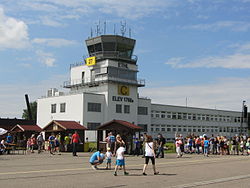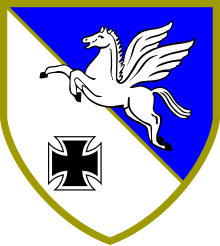Laupheim airfield
| Laupheim airfield | |
|---|---|

|
|
| Characteristics | |
| ICAO code | ETHL |
| Coordinates | |
| Height above MSL | 538 m (1765 ft ) |
| Transport links | |
| Distance from the city center | 3 km southeast of Laupheim |
| Basic data | |
| opening | March 1940 |
| operator | armed forces |
| Runways | |
| 03/21 | 600 m × 50 m grass |
| 09/27 | 1646 m × 30 m asphalt |
The Laupheim airfield is a military airfield in the immediate vicinity of the city of Laupheim in Baden-Württemberg . Originally conceived as a military airfield of the Air Force of the Armed Forces , the airfield from 1964 to 2012 was the army the Bundeswehr as a military airfield used and served as the home base of the Middle transport helicopter regiment 25 "Oberschwaben" . Air force units have been stationed on the field again since 2013 , and it is the home base of Helicopter Squadron 64 . The Kurt Georg Kiesinger barracks is located on the site of the airfield .
history
Laupheim Air Base
In August 1938, work began to build an air force airfield near Laupheim and almost simultaneously in nearby Riississen . The work was successfully completed in March 1940. During the Second World War , Laupheim airfield was the base of various air force units, a training unit, a night fighter squadron and a destroyer squadron.
There was also a small production facility for a forerunner of the modern helicopter on the airfield site . Here Henrich Focke developed and tested his Focke-Achgelis Fa 223 Drache helicopter, the world's first military helicopter. One of his closest employees, the Laupheim engineer Friedrich Hartz , who died in 1993 , still has test models of various folding rotors in the helicopter museum in Bückeburg .
On July 19, 1944, 45 type B-24 bombers of the 8th Air Force of the USAAF bombed Laupheim airfield and dropped 115 tons of high explosive and incendiary bombs. Meanwhile, low-flying attacks on the airfield by fighter planes accompanying the bombers took place. The attack caused considerable damage; seven Messerschmitt Bf 110 destroyers , an Arado Ar 96 aircraft and a Messerschmitt Bf 108 were completely destroyed. Four other aircraft were partially damaged. In addition, the technical equipment of the various squadrons, a hangar, accommodations, air traffic control and three recently built helicopters of the type Focke-Achgelis Fa 223 Drache were destroyed. A flak unit received a direct hit, killing one soldier and injuring four others. Two days later, an anti- aircraft unit shot down a B-24 bomber that had been damaged during an air raid on Munich and was therefore unable to fly at operational altitude. The team was able to save themselves with the parachute . However, the roof of the church in nearby Baustetten was badly damaged by the violent fire of the flak units .
The next air raid took place on July 31, 1944. Eleven P-51 Mustang fighter aircraft carried out low-flying attacks, with two Messerschmitt Bf 110s, an Italian trainer aircraft destroyed and two other Messerschmitt Bf 110s badly damaged. The flak units stationed at the airfield therefore began to get nervous, and when 28 aircraft suddenly appeared from the direction of Schwendi on August 9, 1944 , the flak units immediately opened fire and shot down one aircraft. However, these aircraft belonged to the German Jagdgeschwader 4, which flew Focke-Wulf Fw 190 aircraft.
As a result of the air raids, the Focke-Achgelis production facility was relocated to Ochsenhausen . On November 26, 1944, the airfield was attacked by ten P-47 Thunderbolt , which caused only minor damage. Shortly before the end of the Second World War, the II. Group of Jagdgeschwader 53 (JG 53 "Pik-As") with its Messerschmitt Bf 109 was transferred from the Seyring military airfield near Vienna to the neighboring airfields Laupheim and Rississen on April 2, 1945 . On April 18 and 19, 1945, the Laupheim airfield was attacked again and one soldier was killed. French bomber formations with 75 American machines of the type Martin B-26 Marauder and the fighter planes accompanying them attacked the airfields Laupheim and Riississen again on April 20, 1945. In this attack, all aircraft at the Laupheim airfield were destroyed. The following day the few airworthy aircraft of Group II of JG 53 that remained at the nearby Riississen airfield were relocated to Schongau in Bavaria . A week later the unit in Schongau was disbanded. On April 21, 1945 the twin airfield Riississen and on April 23, 1945 the city of Laupheim and the airfield Laupheim were occupied by French troops.
Laupheim Army Airfield
In 1964, completely new military facilities were built on the site of the former air force airfield, which were intended to accommodate helicopters of the army aviation. During the construction work, the Corps Army Aviation Command 2 was transferred from Ulm to Laupheim. Shortly afterwards the operational flight operations of the army aviation began. The first helicopters to be stationed at the Laupheim Army Airfield were of the Sikorsky H-34 type .
After the strength of the army aviation had been increased during the 1960s, a reorganization followed in 1971, which led to Laupheim becoming the headquarters of all army aviation units in southern Germany. The units stationed in Laupheim, the Army Aviation Battalion 200 and the Army Aviation Repair Squadron 207, were merged to form the 25th Medium Transport Helicopter Regiment .
In 1971 the obsolete Sikorsky H-34 was replaced by the Sikorsky CH-53 , which is still in service with the Army Aviation in Laupheim. In the more than 30 years since the introduction of the CH-53, the regiment flew well over 120,000 hours, including in disaster operations in Italy, Greece, the French Pyrenees and in the avalanche areas of the Alps.
On June 21, 1989, the barracks were named after the former Chancellor Kurt Georg Kiesinger with a ceremony.
In 1994, the Army Aviation Center in Neuhausen ob Eck was dissolved together with the 20 Army Aviation Regiment. This regiment flew the Bell UH-1D. The HFlgStff 10, which was also stationed in Neuhausen ob Eck, flew the Bölkow Bo 105 . The helicopters of this unit were partially relocated to Laupheim and formed the Army Aviation Support Squadron 10. In the same year, the Corps-Heeresfliegerkommando 2 staff was disbanded; the staff and the army airfield were incorporated into a new command structure.
Until the beginning of the 1990s, the army pilots from Laupheim only flew missions within NATO territory. Since then, however, the helicopters from Laupheim have been working in a wide variety of operational areas on behalf of the United Nations , NATO and the EU : first in Iraq after the Second Gulf War , then in the Balkans as part of IFOR , KFOR , SFOR and EUFOR and finally in Afghanistan as part of ISAF .
In 1994, the 25th Medium Transport Helicopter Regiment was given the honorary name of Upper Swabia as a sign that the army aviators were holding onto the Laupheim site after a large number of bases had been closed as part of savings.
In 2002 the 25th Medium Transport Helicopter Regiment was incorporated into the Air Mobile Operations Division .
A Diehl Aviation plant is located on the edge of the airfield . Until October 2008 the plant was part of the aircraft manufacturer Airbus , but was taken over by Diehl as part of the Airbus refurbishment.
Return to the Air Force
As a result of the 2010 adopted basic Bundeswehr reform introduced German Defense Minister Thomas de Maiziere ( CDU ) on 26 October 2011 at the federal cabinet the stationing concept in 2011 before. As a result, the Laupheim location with its 1750 posts (as of October 26, 2011) was reduced to 1630 posts and moved in bulk from the army to the air force. This change was implemented on January 1, 2013. From the end of 2015 helicopters of the type H145M T2 (former designation EC645) were delivered by Airbus Helicopters to the helicopter squadron 64. This militarized version of the civil helicopter H145 (former designation EC145) is primarily intended as a transport helicopter for quickly deployable forces such as the Special Forces Command.
See also
literature
- Gebhard Aders : History of the German night hunt 1917–1945 . Motorbuch Verlag, Stuttgart 1977, ISBN 3-87943-509-X .
- Federal Ministry of Defense: Army of Unity 1990–2000 , Bonn, 2000
- Heeresfliegerregiment 25 (Hsg.): Thirty Years Heeresflieger Laupheim: Jubilee edition . WEKA Verlag, Kissing 1994
- Cajus Bekker: Attack height 4000. A war diary of the German Air Force . Pavillon Verlag, Munich 2003, ISBN 3-453-87098-0 .
- Fritz Berger: Heeresflieger, location Laupheim: information sheet for citizens and soldiers , Mönch Verlagsgesellschaft, Waldesch 1987
- Fritz Berger: German Army Aviators: national and international rescue, aid and UN missions . Stedinger-Verlag, Lemwerder 2005, ISBN 3-927697-41-9 .
- Joachim Dressel, Manfred Griehl: Airplanes and helicopters of the Bundeswehr . Motorbuch-Verlag, Stuttgart 1990, ISBN 3-613-01358-4 .
- Bernd Kaufholz: In the service of "old Europe": helpers in Kabul and elsewhere . Mitteldeutscher Verlag, Halle 2003, ISBN 3-89812-202-6 .
- Bryan Philpott: History of the German Air Force , Gallery Books, Hamlyn 1986, ISBN 0-8317-4208-9 .
- Georg Schenk: Laupheim . Konrad-Verlag, Weißenhorn 1976, ISBN 3-87437-136-0 .
- Kurt W. Schütt: Army Aviators: Military Class of the Third Dimension; the history of the Army Aviation Troops of the Bundeswehr . Bernard and Graefe, Koblenz 1985, ISBN 3-7637-5451-2 .
- Hans Willibold: The air war between Danube and Lake Constance. Preparations, airfields and their occupancy, air strikes, crashes . Federsee-Verlag, Bad Buchau 2002, ISBN 3-925171-54-1 .
Web links
- Field airfield Freifeld , Baltringen near Laupheim
- Homepage of the Bundeswehr
- Air Force Archives 1935–1945
- Helicopter Museum in Bückeburg
Individual evidence
- ^ The stationing of the Bundeswehr in Germany. (PDF; 3.3 MB) Federal Ministry of Defense - Press and Information Office, accessed on April 10, 2018 .






